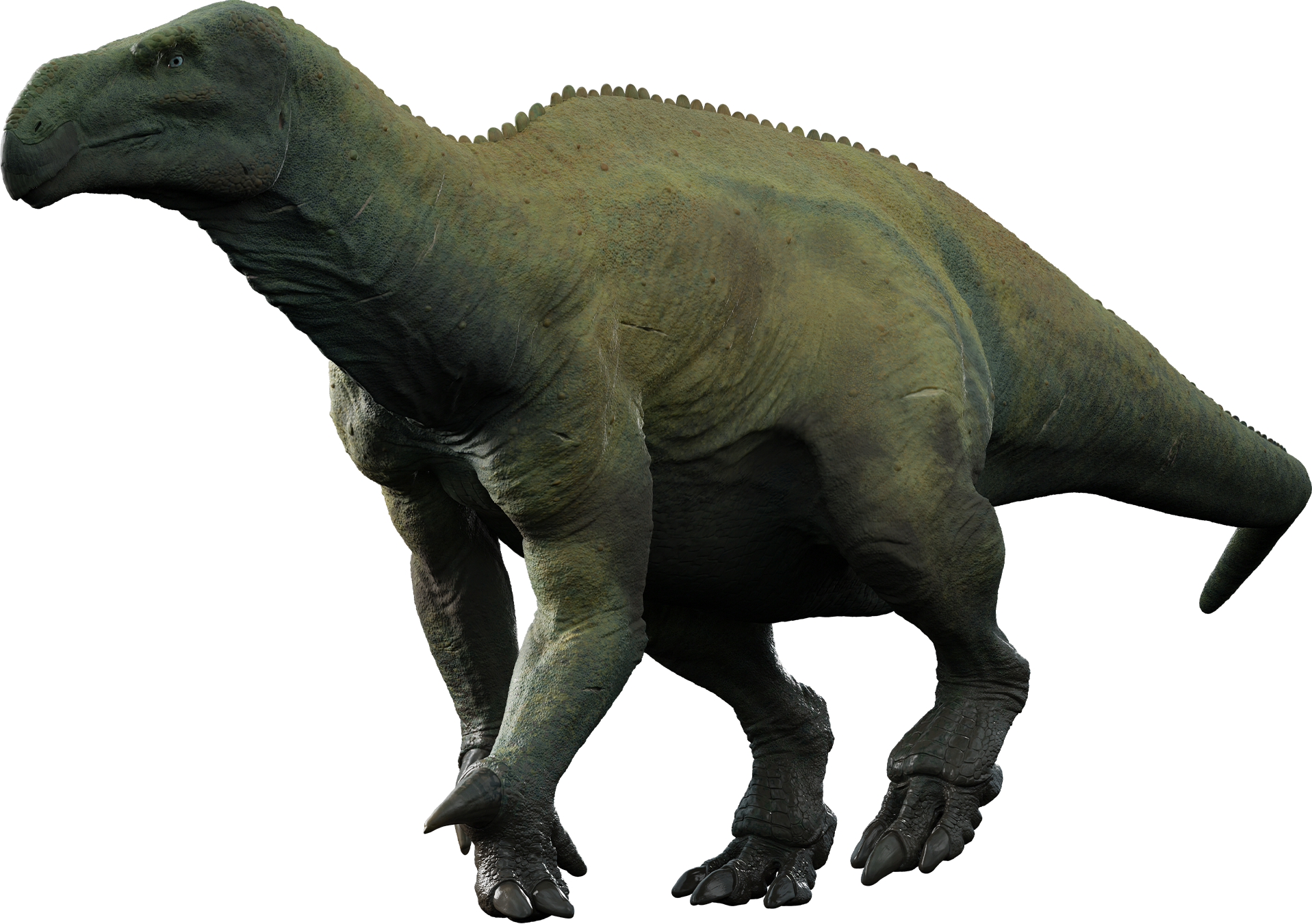Science's Second Dinosaur
Named in 1825, 17 years before the word "dinosaur" was coined, Iguanodon became the second dinosaur to be scientifically named, and the first herbivorous dinosaur known to paleontology.
Overview: In 1824, Megalosaurus became the first dinosaur to be scientifically named. The next year, the world was introduced to the second, Iguanodon, discovered and named by English geologist Gideon Mantell. Unlike Megalosaurus, Iguanodon was an herbivore, originally envisioned as an elephantine iguana-like creature. Since then, the appearance of this Early Cretaceous dinosaur has been updated as our scientific understanding has increased, but Iguanodon has maintained an important and iconic position in the study of paleontology and in the hearts of paleontologists.
Discovery: In 1820, the word “dinosaur” didn’t exist, and geology as a proper science had only recently come into being. Englishman Gideon Mantell was an obstetrician, and after being inspired by the paleontological discoveries of Mary Anning at Lyme Regis, Mantell became an early geologist and paleontologist by hobby, becoming an expert on the geology of the Sussex region of England. In 1820 he found some large bones from a quarry at Whiteman’s Green, near the town of Cuckfield. And in 1822, either he or his wife, Mary Ann Mantell, discovered some strange teeth at Whiteman’s Green. According to some of Mantell’s accounts it was Mary Ann who found them, allegedly while Gideon was visiting a patient, but according to others of Mantell’s accounts he found them himself. In any case, in 1822, he had the teeth of what would become known as Iguanodon.
Mantel showed the teeth to his scientific peers, who at first were rather dismissive of the discovery, thinking them to be or recent origin, not dating back to the Mesozoic. French anatomist Georges Cuvier, at first identified them as teeth of rhinoceros, though geologist Charles Lyell said later that Cuvier had made this identification after a late party and Cuvier recanted his statement the next morning and suggested they might be something more. William Buckland, who named Megalosaurus in 1824, was famously very dismissive, telling Mantell that they were fish teeth. But despite mockery from his peers in England, Mantell persisted in his belief that the teeth were from Mesozoic aged rocks, based on his careful analysis of the strata where the teeth came from. He also discovered that the teeth were very similar to those of an iguana, except 20 times bigger. Finally, in 1825, he was able to prove that the teeth were indeed from rocks of the Mesozoic, and he named his new reptile Iguanodon, meaning “iguana tooth”.
As Mantell had neglected to provide a species name, one was added in 1829 by Friedrich Holl, who named it Iguanodon anglicus, in reference to England. By 1842, additional Iguanodon material (or at least material from related iguanodonts, then identified as Iguanodon) had come to light, and Iguanodon was reconstructed by Richard Owen as a large elephant-like iguana creature with a horn on its nose, and along with Buckland’s Megalosaurus and Mantell’s Hylaeosaurus, Iguanodon was one of the three animals Owen used to define the newly coined Dinosauria. In 1878, at least 38 Iguanodon skeletons were discovered in a coal mine in Bernissart, Belgium. These were named by George Albert Boulenger as Iguanodon bernissartensis, and they showed that the older elephant-lizard reconstruction was incorrect, something which Gideon Mantell had suspected but didn’t have the chance to demonstrate before his death in 1852. Other Iguanodon bernissartensis remains have been found in Germany, England, Spain, and France, and due to the Iguanodon anglicus type specimen being just a tooth, the much better-known Iguanodon bernissartensis was made the type species of Iguanodon in 2000, I. anglicus probably being a synonym of I. bernissartensis. Many other Iguanodon species have been named, but most of these were later found to be separate genera. The only other species of Iguanodon still recognized as a valid species is Iguanodon galvensis from Spain.
Evolution: Iguanodon was a member of the dinosaurian clade ornithischian, called “bird-hipped” dinosaurs, because they all have a backwards pointing pubis. These animals, with few exceptions, were herbivores and include the likes of Triceratops, Stegosaurus, Ankylosaurus, and of course, Iguanodon. Iguanodon was an ornithopod, a clade of mostly bipedal herbivores with advanced teeth for chewing vegetation. And within this group, Iguanodon was a member of the broad group Iguanodontia, which originated in the Middle Jurassic, proliferated in the Early Cretaceous, and lasted until the end of the Cretaceous. Earlier forms included the Late Jurassic Camptosaurus, and in the Late Cretaceous the iguanodonts were represented by the hadrosaurs, or “duck-bills”. Iguanodon, which lived in the Early Cretaceous, was more derived (“advanced”) than Jurassic genera like Camptosaurus, as well as many other Early Cretaceous genera such as Tenontosaurus and Dakotadon (the latter of which was formerly classified as an American species of Iguanodon). Instead, Iguanodon was very close to the ancestry of the first hadrosaurs.
Description: Iguanodon had a fairly typical ornithopod body-plan. They were almost bird-like, except not as much so as the theropods, and had long tails, powerful hind limbs, smaller front limbs, and a beaked mouth. They also had efficient cheek teeth for chewing vegetation, which gave them a digestive advantage over their sauropod competition which swallowed vegetation whole. Iguanodon itself was a rather large and heavily built iguanodont, reaching lengths of 9-11 meters (30-36 ft) and weighing as much as 4.5 tonnes (5 tons). Some could have grown even larger, perhaps 13 meters (43 ft), though these claims may be an overestimate as the largest substantiated remains are 11 meters (36 ft). Iguanodon was a facultative biped, meaning it could shift between walking on all fours or on just its hind legs. The three middle fingers on the hand were inflexible and adapted for bearing weight. The hand also bore a spiked thumb, which may have been a defensive weapon, and a little finger which was more dexterous and may have been used to manipulate objects. Iguanodon’s tail was held horizontal to the ground and kept straight by ossified tendons.
Behavior and Ecology: Iguanodon lived between 126 and 122 million years ago in what is now western Europe. In England, Iguanodon shared its environment with sauropods like Pelorosaurus, the ankylosaur Polacanthus, and fellow iguanodont Mantellisaurus. Iguanodon probably had a feeding range from ground level plants to plants about 4-5 meters (13-16 ft) above the ground. Specifically what type/s of plants Iguanodon ate is unknown, but it has been suggested that ornithopods like Iguanodon may have thrived on eating early angiosperms (flowering plants) and that the spread of angiosperms in the Early Cretaceous may have been partially responsible for the great abundance and diversity of ornithopods at this time and going forward. However, at this point, this is just speculation. In addition to other herbivores, Iguanodon also shared its habitat with predators. These include the medium-sized tyrannosaur Eotyrannus and the moderately large allosauroid Neovenator. Near water, Iguanodon would have had to be wary of spinosaurids like Baryonyx. All of these animals likely preyed upon Iguanodon, and probably more especially juvenile Iguanodon, as adult Iguanodon were a good deal larger than all of these predators. Iguanodon may have used its thumb spike as a defense against these predators. There is also evidence from bone beds with multiple individuals that Iguanodon may have formed into herds for protection, like many modern herbivores do.
Extinction and Legacy: Iguanodon disappeared around 122 million years ago, probably just replaced by more of its own iguanodont kin. Since going extinct, it has become one of the most important scientific discoveries in history. It was one of the first dinosaurs ever discovered and given a scientific name and it was used as one of the defining members of Dinosauria. In 1952, giant models of Iguanodon and other prehistoric creatures were made by Benjamin Waterhouse Hawkins for display at Crystal Palace Park in London, England. These models are highly inaccurate, but they are the first dinosaur life models ever displayed, and thus were the general public’s first major introduction to dinosaurs. Iguanodon featured prominently in Arthur Conan Doyle’s The Lost World, and subsequently have also appeared in various dinosaur media, including Disney’s Dinosaur (2000) and the 1999 BBC documentary Walking With Dinosaurs. Iguanodon is also credited as one of the three dinosaurs that inspired the iconic movie monster Godzilla, the other two being Tyrannosaurus rex and Stegosaurus. Iguanodon can be found in many museums, including the Natural History Museum in London, England, the Royal Belgian Institute of Natural Sciences, in Brussels, Belgium, the Übersee-Museum in Bremen, Germany, the Dinosaur Isle Museum in Sandown, Isle of Wight, England, and the Museum of New Zealand Te Papa Tongarewa in Wellington, New Zealand.
Iguanodon FAQ
Iguanodon size / How big was Iguanodon?
See height, weight, and length.
Iguanodon height / How tall was Iguanodon?
Iguanodon was about 3 meters (9.84 ft) tall.
Iguanodon weight / How much did Iguanodon weigh?
Iguanodon weighed about 4.5 tonnes (5 US tons), similar to a modern Asian elephant!
How long was Iguanodon?
Iguanodon was about 9-11 meters (30-36 ft) long!
What did Iguanodon eat?
Iguanodon ate plants, probably those that grew close to the ground and up to about 4-5 meters (13-16 ft) tall.
What is Iguanodon’s closest living relative?
Like all dinosaurs, the closest relatives of Iguanodon are the only surviving lineage of dinosaurs today, the birds. Crocodilians, while not dinosaurs themselves, are also more distant cousins of dinosaurs.
Iguanodon family members / Iguanodon family / What kind of dinosaur was Iguanodon?
Iguanodon was an ornithischian (“bird-hipped dinosaur”) in the family Iguanodontidae in the larger clade Ornithopoda. It was an earlier cousin of the hadrosaurs (duckbilled dinosaurs).
Where did Iguanodon live? / Where was Iguanodon found?
Iguanodon lived in Europe, which remains having been found in England, Belgium, Germany, Spain, France.
When did Iguanodon live?
Iguanodon lived about 126-122 million years ago in the Early Cretaceous Period.
What does Iguanodon mean? / Iguanodon name meaning
Iguanodon means “Iguana Tooth” due to the similarity of its teeth to modern iguanas.
When was Iguanodon discovered? / Was Iguanodon the first dinosaur named?
Iguanodon was the second dinosaur to be scientifically named (after Megalosaurus in 1824), having been discovered in 1822 by Mary Anne Mantell and named by Gideon Mantell in 1825.

